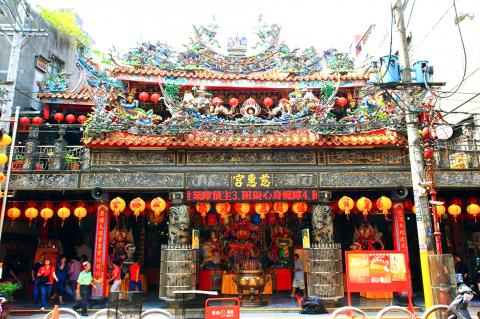The New Taipei City (新北市) Government last week launched a bimonthly journal focusing on interfaith worship, religious festivals, ritual ceremonies and sacred shrines around the city.
The Chinese-language journal, which debuted on Jan. 2, is called Bo Pi New Taipei City (保庇新北市).
Bo pi is the Taiwanese way of referring to divine protection.

Photo: Tseng Te-feng, Taipei Times
Readers can turn to the journal to learn about the diverse religious cultures in the city, city officials said.
Those looking for divine blessings and guidance on gaining wealth, having a son or daughter, finding a lover or job prospects, can find advice in the journal, they said.
According to the city’s Civil Affairs Bureau, New Taipei City was the original starting place for migrant settlement and opening up new lands in northern Taiwan hundreds of years ago.
With such an historic and cultural background, it has an abundance of Buddhist-Taoist temples and Christian churches.
There are 952 registered temples and 120 churches, including 160 Buddhist-Taoist temples that are more than 100 years old, the bureau said.
There are also more than 3,000 Taoist shrines, called shentan (神壇), as well as “deity worship associations” (神明會) under the city’s supervision, the bureau said.
Two of the nation’s five major Buddhist monasteries are located in New Taipei City: Dharma Drum Mountain in Jinshan (金山) and the Ling-Jiou Mountain Monastery in Gongliao (貢寮).
Surveys by the bureau suggest that on average, there are two temples, shentan or churches per square kilometer around the city — with their highest density in Banciao (板橋), Sanchong (三重) and Yonghe (永和) districts.
Hsichih (汐止) and Sansia (三峽) districts have the highest number of registered temples, while Wulai District (烏來) has the fewest registered temples.
The top three deities worshiped in the city’s Buddhist-Taoist temples are the Earth God (土地公), Kuanyin (觀世音) and Matsu (媽祖), government surveys showed.
“From the establishment of these temples and churches, we can follow the historic and demographic development trends of our city. They are also the focus of important local festivals that preserve and pass down the cultural traditions and ritual ceremonies with their unique regional characteristics,” said Chiang Chun-ting (江俊霆), head of the Civil Affairs Bureau.
The bureau has also created a calendar listing temple festivals and religious celebrations for this year, which will be made available online as well as in Bo Pi New Taipei City, he said.
“This way we can introduce the public to the many unique temple festivals and religious celebrations around New Taipei City,” Chiang said.
Bo Pi New Taipei City will be published every other month, on the 20th, and will be available at libraries, local district offices and district household registration offices. It is also produced in ebook format, which can be downloaded at www.ca.ntpc.gov.tw/24;data_pagenode/details/.

Chinese Nationalist Party (KMT) Chairman Eric Chu (朱立倫), spokeswoman Yang Chih-yu (楊智伃) and Legislator Hsieh Lung-chieh (謝龍介) would be summoned by police for questioning for leading an illegal assembly on Thursday evening last week, Minister of the Interior Liu Shyh-fang (劉世芳) said today. The three KMT officials led an assembly outside the Taipei City Prosecutors’ Office, a restricted area where public assembly is not allowed, protesting the questioning of several KMT staff and searches of KMT headquarters and offices in a recall petition forgery case. Chu, Yang and Hsieh are all suspected of contravening the Assembly and Parade Act (集會遊行法) by holding

PRAISE: Japanese visitor Takashi Kubota said the Taiwanese temple architecture images showcased in the AI Art Gallery were the most impressive displays he saw Taiwan does not have an official pavilion at the World Expo in Osaka, Japan, because of its diplomatic predicament, but the government-backed Tech World pavilion is drawing interest with its unique recreations of works by Taiwanese artists. The pavilion features an artificial intelligence (AI)-based art gallery showcasing works of famous Taiwanese artists from the Japanese colonial period using innovative technologies. Among its main simulated displays are Eastern gouache paintings by Chen Chin (陳進), Lin Yu-shan (林玉山) and Kuo Hsueh-hu (郭雪湖), who were the three young Taiwanese painters selected for the East Asian Painting exhibition in 1927. Gouache is a water-based

Taiwan would welcome the return of Honduras as a diplomatic ally if its next president decides to make such a move, Minister of Foreign Affairs Lin Chia-lung (林佳龍) said yesterday. “Of course, we would welcome Honduras if they want to restore diplomatic ties with Taiwan after their elections,” Lin said at a meeting of the legislature’s Foreign Affairs and National Defense Committee, when asked to comment on statements made by two of the three Honduran presidential candidates during the presidential campaign in the Central American country. Taiwan is paying close attention to the region as a whole in the wake of a

OFF-TARGET: More than 30,000 participants were expected to take part in the Games next month, but only 6,550 foreign and 19,400 Taiwanese athletes have registered Taipei city councilors yesterday blasted the organizers of next month’s World Masters Games over sudden timetable and venue changes, which they said have caused thousands of participants to back out of the international sporting event, among other organizational issues. They also cited visa delays and political interference by China as reasons many foreign athletes are requesting refunds for the event, to be held from May 17 to 30. Jointly organized by the Taipei and New Taipei City governments, the games have been rocked by numerous controversies since preparations began in 2020. Taipei City Councilor Lin Yen-feng (林延鳳) said yesterday that new measures by